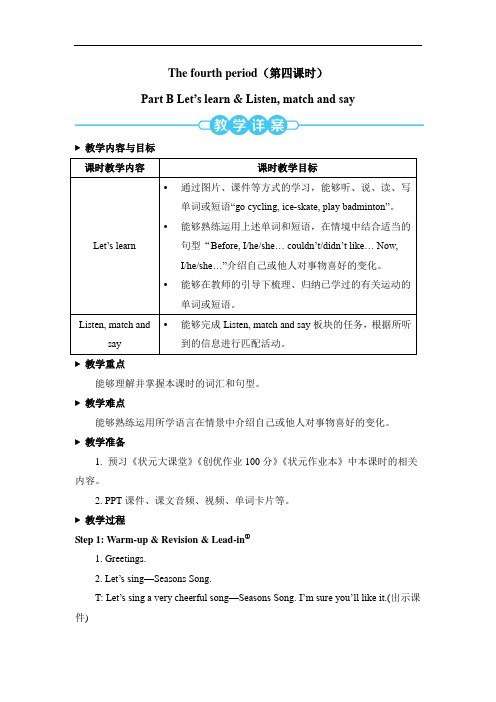小学六年级英语第四课时
- 格式:doc
- 大小:66.00 KB
- 文档页数:4

The fourth period(第四课时)Part B Let’s learn & Listen, match and say▶教学内容与目标▶教学重点能够理解并掌握本课时的词汇和句型。
▶教学难点能够熟练运用所学语言在情景中介绍自己或他人对事物喜好的变化。
▶教学准备1. 预习《状元大课堂》《创优作业100分》《状元作业本》中本课时的相关内容。
2. PPT课件、课文音频、视频、单词卡片等。
▶教学过程Step 1: Warm-up & Revision & Lead-in①1. Greetings.2. Let’s sing—Seasons Song.T: Let’s sing a very cheerful song—Seasons Song. I’m sure you’ll like it.(出示课件)3. Lead-in.Show the word cards of the four seasons.T: Which season do you like best?S s: I like…best.T: What can you do in…?Ss: I can…◆Teaching purpose①通过欢快的歌谣导入新课,迅速调动学生学习的注意力和积极性。
以基于歌曲话题的简短师生对话复习旧知,导入本课主题。
Step 2: Presentation②1. Learn the phrase “go cycling”.T: In different seasons, the weather is different. We can do lots of different activities. Brainstorm the relative activities.T: It’s warm in spring. What activities can you do?(课件出示:春天景色图)Ss: I can fly a kite/have a picnic/plant trees/go hiking/go cycling/…(Write down the relative phrases on the blackboard.)Teach the word “cycle” and the phrase “go cycling”. When “cycle” performs as a noun, it means “bike”. When it performs as a verb, it means “ride a bike”. And we can also say “go cycling”. Let students read the phrase after the recording. (课件出示:go cycling的图片及音频)2. Learn the phrase “play badminton”.T: How do you feel in autumn, cool or cold? (课件出示:秋天景色图)Ss: I feel cool.T: Yes, the cool weather is very good for many sports. What sports can you do in autumn?Ss: I can play ping-pong/basketball/football/badminton…Teach t he phrase “play badminton”. Lead students to read and memorize the word “bad-min-ton” in syllables. Let students read the phrase after the recording. (课件出示:play badminton的图片及音频)◆Teaching purpose②创设情境,导入季节、天气和活动,激活学生在不同季节中能进行的活动的相关语言,顺势导入新词,学习本课的核心单词和短语。


小学英语教学、学习精品资料The fourth period(第四课时)Part B Let’s learn & Play card games▶教学内容与目标课时教学内容课时教学目标Let’s learn ·通过图片、课件等,结合教材中陈杰、吴一凡、Mike和Oliver在不同情境中表现的不同情绪和感受,以及教师、父母和朋友分别提出了针对性的建议来疏导他们情绪的场景,学会听、说、读、写词组:see a doctor, do more exercise, wear warm clothes, takea deep breath, count to ten·能够熟练运用句型“You should…”提出合理建议Play card games ·能够根据同伴抽到卡片的内容,提出相应的建议能够听、说、读、写并熟练运用下列词组:see a doctor, do more exercise, wear warm clothes, take a deep breath, count to ten。
▶教学难点能够用所学词组和句型来针对不同情况提出合理建议。
▶教学准备1.预习《状元大课堂》《创优作业100分》《状元作业本》中本课时的相关内容。
2. PPT课件、课文录音、视频、卡片等。
▶教学过程Step 1: Warm-up & Revision & Lead-in1. Greetings.2. Revision.Show the pictures on page 60 to students. Talk about the pictures with students.(课件出示:教材P60 Let’s talk板块下方的图片)Students talk about the pictures in pairs.A: What’s wrong with you?B: I’m angry.A: Don’t be angry. You should take a deep breath.…3. Free talk.Prepare the word cards about “ill, sad, angry, worried”.Ask several students to choose one card and act it out.T: What’s wrong with h im/ her?Ss: Are you ill/ sad/ angry/ worried?S1: Yes. I’m angry./…T: What should he/she do? Can you give him/her some suggestions?Ss: You should…4. Lead-in. Teaching purpose借用上节课的图片进行对话练习,帮助学生复习相关句型,自然导入新课。



六年级上册英语说课稿《Unit 4 I have a pen pal第四课时》人教(PEP)一. 教材分析《Unit 4 I have a pen pal》是人教版PEP小学英语六年级上册的一单元,本单元的主题是关于笔友的交流。
通过本单元的学习,学生能够掌握有关描述人物外貌、喜好和日常生活等方面的词汇和句型,并能够运用所学知识进行简单的交流。
第四课时主要围绕着Let’s learn、Let’s do、Let’s spell和 Story time展开,使学生能够通过不同的途径进一步巩固本单元的知识点。
二. 学情分析在进入六年级上册的学习时,学生已经掌握了大量的英语词汇和基本句型,具备了一定的听、说、读、写能力。
然而,在实际运用英语进行交流时,部分学生还存在一定的困难,如发音不准确、句子结构混乱等。
因此,在教学过程中,需要关注学生的个体差异,针对不同学生的学习需求进行引导和帮助。
三. 说教学目标1.知识目标:学生能够听、说、读、写本课时的新词汇和句型,掌握描述人物外貌、喜好和日常生活的表达方式。
2.能力目标:学生能够在实际情景中运用所学知识进行交流,提高英语运用能力。
3.情感目标:培养学生热爱英语、积极参与课堂活动的兴趣,增进同学间的友谊。
四. 说教学重难点1.重点:本课时的重点是掌握新词汇和句型,能够用英语描述人物外貌、喜好和日常生活。
2.难点:学生能够正确运用所学知识进行实际交流,提高英语运用能力。
五. 说教学方法与手段1.情景教学法:通过设置真实、有趣的情景,激发学生的学习兴趣,提高学生的参与度。
2.任务型教学法:通过完成各种任务,培养学生的合作精神和实践能力。
3.游戏教学法:通过设计富有挑战性和趣味性的游戏,巩固所学知识。
4.多媒体教学手段:利用多媒体课件、图片、视频等资源,丰富教学内容,提高学生的学习兴趣。
六. 说教学过程1.热身(5分钟):通过唱一首英文歌曲,激发学生的学习兴趣,营造轻松愉快的课堂氛围。
The fourth period(第四课时)Part B Let’s try & Let’s talk内容分析本课是PEP小学英语六年级第一册Unit 4第四课时。
主要学习并在情景中恰当运用句型“—Does he/she…? —Yes, he/she does./No, he/she doesn’t.”谈论他人信息。
老师将通过多种教学活动巩固重点单词和句型,使学生掌握本节课知识点。
课时目标知识与能力·能够读懂Let’s try板块的题目要求,学会听前预测要听的重点内容·通过完成听力题目能对即将发生的故事进行预测·能运用基本听力技巧完成主旨题和细节题·能够通过观察、谈论Let’s talk板块的图片,在图片和教师的帮助下理解对话大意,并能回答对话下面的问题·能够通过听录音,学会按照正确的意群及语音、语调朗读对话,并能在小组中进行角色表演·能够听、说、读、写并在情景中恰当运用句型“—Does he/she…? —Yes, he/she does./No, he/she doesn’t.”谈论他人信息,并通过对话简单了解澳大利亚的首都堪培拉和著名城市悉尼·能够在语境中借助图片等帮助理解新词“Canberra, amazing”的意思,并能正确发音过程与方法基于对话创设一些有关John的信息,帮助学生更多地了解Wu Yifan的笔友。
以一般疑问句的形式操练本课的核心句型,也为接下来的巩固活动拓展相关表达,做好充分的语言准备。
情感态度价值观指导学生根据教材下方表格完善给John的交友信息,使学生能熟练运用所学语言谈论自己的相关信息以及兴趣爱好。
同时渗透结交朋友要有共同兴趣爱好的情感教育。
教学重难点教学重点1.能够理解和掌握本课时的重点词汇和句型。
2.能够听、说、读、写并在情景中恰当运用句型“—Does he/she…? —Yes,he/she does./No, he/she doesn’t.”谈论他人信息教学难点能够听、说、读、写并在情景中恰当运用句型“—Does he/she…? —Yes, he/she does./No, he/she doesn’t.”谈论他人信息。
人教PEP六年级上册英语教学设计《 Unit 4 I have a pen pal 》第四课时一. 教材分析《Unit 4 I have a pen pal》是人教PEP六年级上册英语第四课时的教学内容。
本课时主要讲述了学生们介绍自己的笔友以及笔友的个人信息。
通过本课时学习,学生能够掌握重点单词和句型,并能运用所学知识进行实际交流。
教材内容丰富,插图生动,有利于激发学生的学习兴趣。
二. 学情分析六年级的学生已经具备了一定的英语基础,能够听、说、读、写一些简单的英语句子。
在学习本课时,学生需要进一步巩固已学的知识,提高交际能力。
此外,学生对于介绍自己和他人还有一定的好奇心,可以通过本课时内容满足他们的求知欲。
三. 教学目标1.知识目标:学生能够掌握本课时重点单词和句型,并能正确运用。
2.能力目标:学生能够听、说、读、写关于介绍自己和笔友的句子,提高交际能力。
3.情感目标:培养学生热爱英语、积极参与课堂活动的兴趣,增进同学间的友谊。
四. 教学重难点1.重点:本课时重点是让学生掌握并能正确运用关于介绍自己和笔友的单词和句型。
2.难点:学生需要能够在实际情景中灵活运用所学知识进行交流。
五. 教学方法1.情景教学法:通过设定真实的情景,让学生在实际交流中掌握知识。
2.任务型教学法:通过完成各种任务,激发学生的学习兴趣,提高实践能力。
3.互动式教学法:鼓励学生积极参与课堂活动,增强课堂活力。
六. 教学准备1.教师准备:提前准备好教材、课件、实物等教学资源。
2.学生准备:预习本课时内容,了解基本知识。
七. 教学过程1.导入(5分钟)教师通过与学生谈论他们自己的朋友和笔友,引出本课时主题。
然后,呈现教材插图,让学生回答相关问题,激发学生的学习兴趣。
2.呈现(10分钟)教师展示本课时重点单词和句型,并用实物或图片进行辅助教学。
让学生跟读,确保他们正确掌握。
3.操练(15分钟)教师学生进行小组活动,让他们用所学知识进行角色扮演,模拟介绍自己和笔友的情景。
英语—第四课时一.填写单词。
1. __ __ f __ __ __ 步行, 走路2. __ __ __ __ __e 骑自行车3. by t __ __ __ __ 乘火车4. __ __ __ __ 停5. __ __ __ __ 等6. __ __ b __ __ __ __ 图书馆7. c __ __ __ __ __ 电影院8. __ __ __ pi __ __ __ 医院9. m __ __ __ __ __ 博物馆10. __ __ the __ __ __ __ 在左边11. __ __ the __ __ __ __ __ 在右边12. t __ __ __ __ __ __ __ 左转13. __ __ __ n __ __ __ __ __ 右转14. u __ u __ __ __ __ 通常15. o __ __ __ __ 经常16. s __ __ __ t __ __ __ __ 有时二. 找出每组单词中与其他三个发音不同的一个,将其编号填入括号里。
1. ()A. low B. now C. down D. cow2. ()A. cut B. music C. puppy D. luck3. ()A. boot B. foot C. room D. zoo4. ()A. family B. nature C. Saturday D. traffic5. ()A. letter B. member C. person D. teacher三.选择正确的答案,将其编号填入括号里。
()1.I want _______ a map of China.A. buyB. is buyingC. to buyD. am buying()2. Is it a picture ______ your school?A. ofB. toC. andD. with()3. Do you like _______?A. swimB. swimmingC. are swimmingD. swim, too()4. We usually stay _____ home ____ Saturday afternoon.A. at…inB. at…onC. in…atD. on…on()5. –It’ s a white shirt, is it yours?-- No, ____ is yellow.A. IB. MyC. MineD. Me()6. ______ any men in the room?A. Is thereB. Are thereC. There aren’tD. There isn’t()7. The bed ______ the right is yours.A. onB. inC. atD. of()8. My parents often tell me ______ China.A. aboutB. fromC. forD. by()9. The man ______ a stick (手杖) is my grandpa.A. andB. ofC. withD. for()10. Who’s the lady ______ blue?A. inB. onC. atD. with四.选择合适的单词将短文补充完整,每词只用一次。
a in are three rules left right green red yellowYou must know the traffic _________ if you walk _________ a city. The traffic lights are the same in every city. There _________ always _________ lights. You can cross the street at the _________ light and you must stop at the _________ light. The _________ light means “Slow down and stop”. If you drive _________ car, you must drive on the _________ side of the road in China. But in England, people drive on the _________ side of the road.五.完形填空。
Jim Green is an announcer (播音员)for the program. Most of the girls___1____ boys like the program. They ___2___like Jim Green. Some of them often make phone calls to him and thank him ___3___ his work. There are lots of ___4___ to him every day, too.Jim Green gets up at 6:00 every morning. He has bread and a glass of milk ___5___ breakfast. He leaves home at 6:30 and ___6___ his office at 7:15.The program ___7____ at 7:30.He plays the new records (唱片)of the pop songs and modern music for his listeners. At 8:00 it's time ____8____ the news.Jim finishes work at 10:30. He goes home ____9____ his car. He ___10___ newspaper and listens to music after supper.He thinks his life is very interesting.()1. A. and B. with C. but D. about()2. A. too B. to C. also D. so()3. A. to B. for C. of D. and()4. A. letter B. letters C. friends D. words()5. A. at B. with C. for D. to()6. A. goes B. gets C. gets to D. gets up()7. A. begins B. finishes C. over D. start()8. A. to B. for C. of D. in()9. A. by B. in C. on D. takes()10. A. looks B. reads C. sees D. watches六.根据短文内容选择正确答案,将序号填在题前括号内。
( A )Annie sat in their backyard (后院), thinking. She was trying to think of a way to earn money during the summer vacation. Suddenly, she had an idea! Her parents paid her to walk their dog every day. Maybe other people would pay her to walk their dogs.Annie went to many houses and asked the people if she could exercise their pets. Some of the people didn't have a dog. Others wanted to walk their own pets themselves, but five people did hire Annie. She was delighted.Every morning that summer she walked the dogs. By the end of the vacation, Annie had saved eighty dollars.( ) 1.The best title is ______________.A. Traveling During the SummerB. Waiting for School to BeginC. A Girl Finds a PetD. Getting Paid to Walk Dogs( ) 2. During the vacation Annie saved _________.A. five dollarsB. eighty dollarsC. one hundred dollarsD. ninety dollars( ) 3. To earn money, Annie _______________.A. washed windowsB. sold papersC. went to schoolD. walked dogs( ) 4. When Annie was working, she was __________.A. outsideB. in a carC. in a lakeD. inside a house( ) 5. The underlined word "delighted" means "_________".A. very tallB. very happyC. sickD. cold( B )Lot of boys and girls in Western Countries are wearing the same kinds of clothes, and many of them have long hair, so it is often difficult to tell whether they are boys or girls.One day, an old man went for walk in a park in Washington, and when he was tired, he sat down on a bench. A young person was standing on the other side."My goodness!" the old man said the person next to him on the bench. "Do you see that person with long hair? Is it a boy or a girl?""A girl," said his neighbour. "She's my daughter.""Oh!" the old man said quickly. "Please forgive me. I didn't know that you were her mother.""I'm not," said the other person, "I'm her father."( ) 1. Some of the boys Western Countries look like girls because ________.A. they are not tall enoughB. they walk slowly like girlsC. their clothes and hair are like girls'D. they always wear very fine clothes( ) 2. The old man went to the park one day ________.A. to have a walkB. to see the young personsC. to do some exercisesD. to sit on the bench and have a walk( ) 3. When the old man saw a young person with long hair he thought ________.A. it was a young womanB. it was a boyC. it was a girlD. it was the person's daughter( ) 4. What was the person next to the old man look like? ________.A. He looked like a business man(商人).B. He looked like a young man.C. He looked like the young person's father.D. He looked like a woman.( ) 5. This story happened(发生)in ________.A. FranceB. EnglandC. AmericaD. Australia( C )( ) 1. You may take the _____ bus if your live near the Daping and have lessons at eight.A. five fiftyB. twenty past sixC. six fiveD. twenty-five to seven( ) 2. Which bus can take you to the Book shop before eight?A. Bus 1B. Bus 2C. Bus 3D. Bus 4( ) 3. If you live near the bus stop, you may take Bus 4 to the park at ______.A. 6:25B. 6:45C. 6: 55D. 7:18( ) 4. How long does it take to go to school before eight by bus if you live near the park and have breakfast at six forty?A. About one hour.B. Thirty minutes.C. One hour and ten.D. One hour and two.( ) 5. What time must you get on the bus if you live near the factory and want to buy some books at nine o'clock?A. About twenty past sevenB. Half past sevenC. A quarter to eightD. Forty past seven。